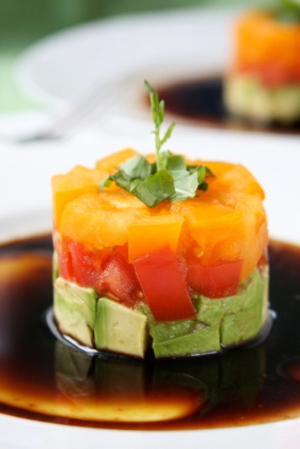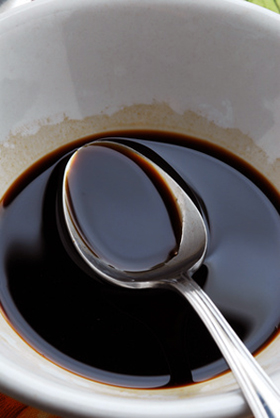 |
 |
Saba (vin cotto) is an instant garnish or sauce for many dishes. Here, a molded salad of avocado, tomato and mango. Photo by Jan Infante | IST.
|
| WHAT IT IS: A sweet cooking and garnishing syrup from ancient Rome: the father of balsamic vinegar. |
| WHY IT’S DIFFERENT: It isn’t made from wine, so it doesn’t have the acidity of a vinegar product. |
WHY WE LOVE IT: Another easy way to add exciting flavor to just about any dish, sweet or savory. |
| WHERE TO BUY IT: See products below. |
|
|
 |
 Saba, Sapa Or Vin Cotto: Page 2: How To Use It Saba, Sapa Or Vin Cotto: Page 2: How To Use It
Introduction To Saba/Vin Cotto
An Italian saying goes, “Sugar sweetens, saba flavors.” The expression also says “Sugar sweetens, vin cotto flavors,” depending on what region you’re in. Saba, sapa, mosto cotto. mosto d’uvo cotto* or vin cotto, you’re dealing with a syrup made from reduced, fresh-pressed grape juice.
*Mosto cotto = cooked must; mosto d’uvo cotto = cooked grape must. The terms refer to the same thing: Must is fresh grape juice.
Instead of a one-dimensional sweetness from refined sugar, saba delivers a natural, fruity, slightly sweet cooked grape syrup† with hints of plum, raisin and other dark fruits. Some have strong butterscotch notes, like white wines aged in oak barrels. Others we’ve tasted have hints of smoke. There are as many different flavor profiles as there are producers.
†You will see saba/vin cotto referred to as “wine syrup.” That’s incorrect. It isn’t wine; it is made from fresh-pressed grape juice and contains no alcohol.
Let us repeat—because there is so much misstated information out there
- Saba is not “cooked balsamic vinegar” (balsamic vinegar is also cooked). It is pre-balsamic vinegar.
- Saba is not a vinegar of any kind. It is cooked grape juice (must) with no vinegar in it. That’s what makes it different from balsamic, which is cooked must plus vinegar.
- Verjus, saba’s sister, is made from the same must but is not cooked.
You know what to do with balsamic vinegar, but what about vin cotto?
The uses are as vast as your culinary imagination—from a beverage (added to sparkling water) to granita (sprinkled over shaved ice) and ice cream. Think balsamic without the tartness.
We use it to:
Breakfast
Lunch & Dinner
- Garnish (drizzle) or sauce for meat, poultry, seafood and vegetable dishes, including grilled vegetables
- Marinades and salad dressings, plus deglazing
- Drizzle over sharp, aged cheeses
- Drizzle over beans and grains (especially polenta)
- Drizzled on fresh or grilled fruits
- Top ice cream, sorbet, plain cakes and baked goods
Cooking & Baking
- Instead of sugar: in bread and tomato sauce
Want to make your own saba? There’s a recipe below.
|
INDEX OF REVIEW
This is Page 2 of a two-page review. Click on the black links to visit other pages:
|
MORE TO DISCOVER
|
Saba Recipe
Saba is no longer widely used in Italy. The last stronghold was the Marche region of central Italy until the mid-20th century. It is still produced there today, but as a rarity. Balsamic is now king.
Here is a recipe from the great chef Pellegrino Artusi (1820-1911), who is to Italian cooking what Brillat-Savarin is to French cooking. Those who want a second career in fine cuisine should note that Artusi retired from a career as a silk merchant to devote his time to cuisine. He completed his masterful cookbook, 1891, at age 71, he completed his cookbook, La Scienza In Cucina e L’arte di Mangiare Bene (The Science of Cooking and the Art of Eating Well), at the age of 71.
It has never been out of print in Italy, and you can buy the English translation. The paperback edition has an introduction that adds the history of the book and its importance in the context of Italian history and politics.
Artusi’s recipe for sapa begins with 2-1/2 k (5-1/2 pounds) of ripe grapes: |
|

Photo of saba (vin cotto) by Comugnero Silvana | Fotolia. |
- Crush some superior quality white grapes (ideally they should still be on the bunch), put the grapes and their juice in a bowl, and when the whole has fermented for about 24 hours, press and filter the must though a fine muslin bag into a pot. Set the must on the fire and boil it down for many hours, till it has reached the consistency of syrup, and bottle it.
Frankly, it’s easier to buy a bottle. And well worth the culinary adventure.
—Karen Hochman
Do you have friends who would enjoy THE NIBBLE?
Click here to send them an invitation to sign up for their own copy. |
© Copyright 2004-2025 Lifestyle Direct, Inc. All rights
reserved. All information contained herein is subject to change at any time
without notice. All details must be directly confirmed with manufacturers, service
establishments and other third parties. The material in this e-zine may not
be reproduced, distributed, transmitted, cached, or otherwise used, except with
the prior written permission of Lifestyle Direct, Inc.
|
|

|
 |